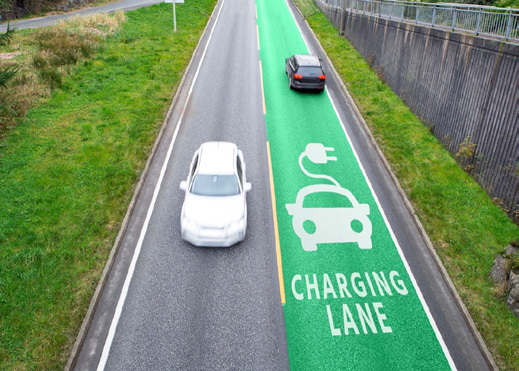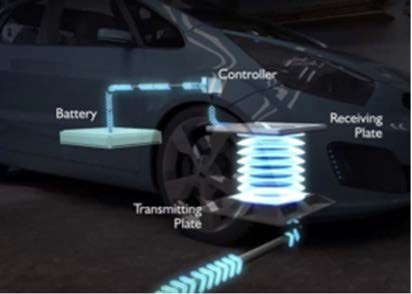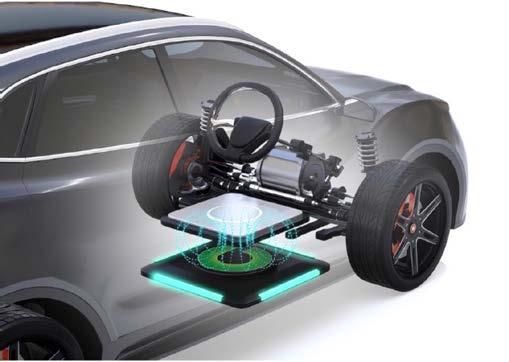Imagine a world where your electric vehicle recharges itself, without any bulky cables or domestic installations, simply by parking in a designated space. Or, even more futuristically, roads would be able to recharge your vehicle as you drive along...
This is not fiction, but a project that companies like Tesla are working hard on. With the recent acquisition of wireless charging specialist Wiferion, Tesla has signalled its desire to be a pioneer in this field. But what is wireless charging for electric vehicles? How does it work, and why is there so much interest in it?
History of wireless charging
for electric vehicles
Statistical Overview
The concept of the electric vehicle dates back to the early 19th century, when inventors around the world experimented with battery-powered cars and trams. However, it wasn't until the late 20th and early 21st centuries that EVs emerged, thanks to advances in battery technology and environmental concerns. Naturally, with the growing adoption of EVs came the need for efficient and convenient charging solutions. Since then, traditional charging methods involving physical connectors and cables have become the norm. These methods are effective, but they come with their own set of difficulties, such as worn connectors, the need for manual plugging and potential risks in adverse weather conditions, to name but a few.
The search for a more seamless and user-friendly charging experience has led innovators to explore the possibilities offered by wireless charging. Inspired by the principles of electromagnetic induction, which is very similar to the way wireless phone chargers work, researchers began to develop systems for transferring energy without any physical connection. The first prototypes of wireless chargers for electric vehicles were introduced in the late 1990s and early 2000s, marking the start of a new era in electric vehicle infrastructure. Companies and research institutes began to recognise the potential of this technology. Pilot projects were launched in several cities to test the feasibility and effectiveness of wireless charging for public transport vehicles such as buses and trams.
The idea of wireless charging is not limited to fixed charging points. The concept also incorporates the idea of dynamic wireless charging, i.e., roads equipped with charging coils that can power vehicles in motion. Although still in its infancy, this idea promises to transform our motorways into perpetual sources of energy. With giants like Tesla jumping into the fray, wireless charging of electric vehicles has gone from being an experimental project to a possible commercial reality. The acquisition of companies specialising in wireless charging, combined with increased investment in R&D, is evidence of a strong desire across the industry to make wireless charging a new standard.

Technical aspects
The role of unions
Electromagnetic induction was first discovered by Michael Faraday in the early 19th century. This innovative technology is based on the simple but profound concept that a changing magnetic field in one coil induces an electric current in a neighbouring coil. In wireless recharging of electric vehicles, the first coil, often called the transmitter, is usually buried in the ground or in a recharging base. The second coil, called the receiver, is located at the bottom of the vehicle. When electricity flows through the transmitter coil, it generates a magnetic field. This field in turn induces a voltage in the receiver coil, enabling the vehicle's battery to be charged. The ground element, or transmitter plate, is what you generally find in car parks or specialist garages.
This plate is directly connected to the electrical network and houses the transmitter's critical coil. On the other side, the receiving plate, fixed under the vehicle, is connected to the car's battery. The efficiency of this energy transfer is ensured by resonators. These components are essential to ensure that the transmitter and receiver 'resonate' at the same frequency, optimising energy transfer and minimising potential losses. In addition, an electronic control unit manages the flow of energy, ensuring that the charging process is both safe and efficient. This unit also communicates with the vehicle and adjusts the charge rate according to the battery's current needs.

Source: Murata
As well as the undeniable convenience that these charging methods can offer, wireless charging has a number of additional advantages over traditional methods. Firstly, the absence of physical connectors means that the system is less susceptible to wear and tear. In addition, environmental factors such as rain, snow or dirt can sometimes compromise plug-in chargers, whereas they pose little or no threat to wireless systems. As for the future, there is a palpable enthusiasm and curiosity around the concept of dynamic wireless charging. This vision is more ambitious and involves integrating transmitter coils directly into the road surface. As vehicles travel along these roads, the coils are activated sequentially, providing a continuous charge. Such an innovation has the potential to revolutionise long-distance EV travel and give it the edge over combustion engines.
Key market players in the EV wireless charging industry
Several companies are at the forefront of this revolution, each offering unique solutions and perspectives. Among the major players shaping this sector, one of the most important is Tesla. Its efforts in the field of wireless charging have been marked by strategic moves, the most notable being the acquisition of Wiferion, a German company specialising in wireless charging solutions. This acquisition not only reinforces Tesla's already outstanding technical prowess, but also demonstrates its commitment to making wireless charging a mainstream option for its vast user base. By leveraging Wiferion's expertise, Tesla is poised to integrate efficient and fast wireless charging capabilities into its vehicles, further strengthening its position as the industry leader.
But Tesla is not the only player in this field. EVgo, one of the largest public EV charging networks in the US, is exploring wireless charging solutions to improve user convenience. The focus on fast charging infrastructure combined with wireless technology could redefine public charging experiences. Other players such as HEVO (Hybrid & Electric Vehicle Optimization) are proposing an interesting approach. Their wireless charging solutions are designed not only for cars, but also for a whole range of vehicles, including delivery trucks and drones. Volta Charging offers another interesting approach to this innovation. As well as offering free charging to EV users, their stations also serve as advertising platforms.

Overall, these companies are not content to develop technologies in isolation. Whether it's more efficient charging pads or dynamic on-the-go charging solutions, these innovations are the result of collective efforts. As these companies continue to push the boundaries, the primary beneficiaries are consumers who can enjoy a seamless, efficient, and futuristic charging experience.
Advantages and disadvantages of wireless charging for electric vehicles
Wireless charging however presents a number of challenges. The first of these, and probably the biggest, is infrastructure development. Moving to wireless charging on a large scale requires major infrastructure changes. The installation of charging points in public car parks, the upgrading of existing charging stations and the possible installation of charging coils on roads all require considerable investment and logistical planning, which is likely to be met with resistance from local communities. Then there are the efficiency issues mentioned above. Although advances in wireless charging have made it increasingly efficient, there are still concerns when compared with traditional charging methods. It is essential, for both economic and environmental reasons, to ensure minimal energy loss during the transfer process. Finally, as you can probably imagine, the initial installation costs of wireless charging systems can be higher than those of traditional charging solutions. Although prices are expected to fall as the technology matures and adoption rates increase, the initial investment can be a significant deterrent for some consumers and businesses.

Future prospects and conclusion
Forecasts point to strong growth in wireless charging infrastructure, driven by both technological advances and growing consumer demand. As cities become increasingly intelligent and connected, wireless charging stations can be expected to become as ubiquitous as traditional petrol stations once were. One of the most eagerly awaited innovations in this area is dynamic charging on motorways. Imagine motorways dotted with recharging coils, powering vehicles as they go. Such a system could virtually eliminate range anxiety and make EVs the preferred choice for all kinds of journeys. Another exciting prospect is the integration of wireless charging with renewable energy sources, which conjures up almost utopian images of energy use. As the world faces the challenges of climate change, the synergy between clean energy and electric vehicles is becoming increasingly crucial. Wireless recharging stations powered by solar energy or recharging centres powered by wind energy could make the process of recharging electric vehicles even more sustainable. Ultimately, the role of wireless charging goes beyond mere convenience. It is a key piece in the jigsaw of a sustainable transport future. As fossil fuel reserves dwindle and environmental concerns intensify, wireless EV charging represents a bastion for a cleaner, greener future for all.
Disclaimer
This marketing document has been issued by Bank Syz Ltd. It is not intended for distribution to, publication, provision or use by individuals or legal entities that are citizens of or reside in a state, country or jurisdiction in which applicable laws and regulations prohibit its distribution, publication, provision or use. It is not directed to any person or entity to whom it would be illegal to send such marketing material. This document is intended for informational purposes only and should not be construed as an offer, solicitation or recommendation for the subscription, purchase, sale or safekeeping of any security or financial instrument or for the engagement in any other transaction, as the provision of any investment advice or service, or as a contractual document. Nothing in this document constitutes an investment, legal, tax or accounting advice or a representation that any investment or strategy is suitable or appropriate for an investor's particular and individual circumstances, nor does it constitute a personalized investment advice for any investor. This document reflects the information, opinions and comments of Bank Syz Ltd. as of the date of its publication, which are subject to change without notice. The opinions and comments of the authors in this document reflect their current views and may not coincide with those of other Syz Group entities or third parties, which may have reached different conclusions. The market valuations, terms and calculations contained herein are estimates only. The information provided comes from sources deemed reliable, but Bank Syz Ltd. does not guarantee its completeness, accuracy, reliability and actuality. Past performance gives no indication of nor guarantees current or future results. Bank Syz Ltd. accepts no liability for any loss arising from the use of this document.
Related Articles
After months of escalating tensions, on 3 January, the United States carried out a large-scale operation in Venezuela, extracting President Nicolás Maduro and First Lady Cilia Flores.
Below are the top 10 events and surprises that could impact financial markets and the global economy in the New Year. These are not forecasts, but potential macroeconomic, geopolitical, or market events that are not anticipated by financial markets. We also try to assess the probability of occurrence (high, medium, low) of each of them.
Gemini 3 has just been ranked as the best performing AI model, a reversal that few saw coming. A year ago, OpenAI models were leading the charts.



.png)